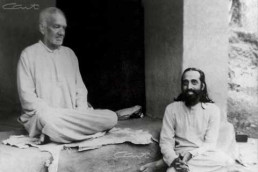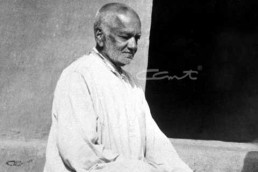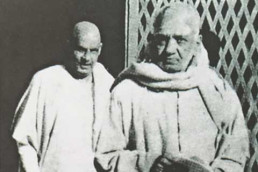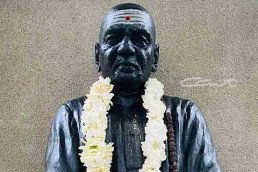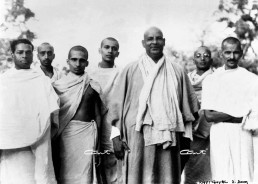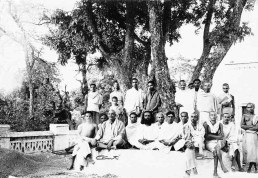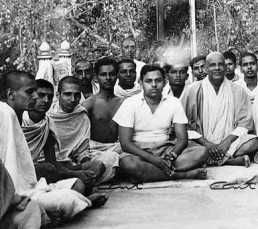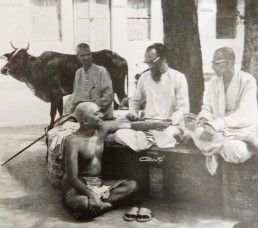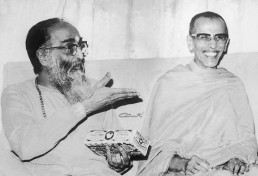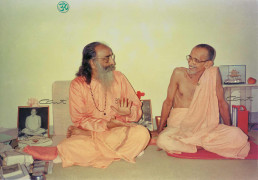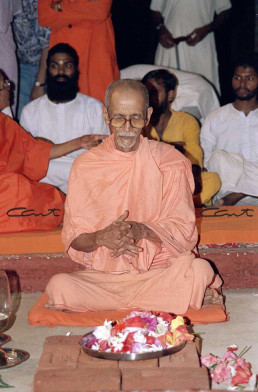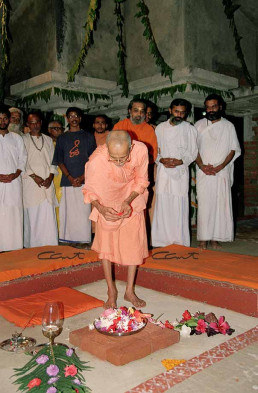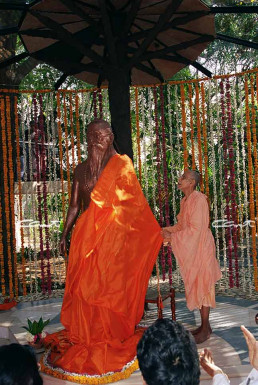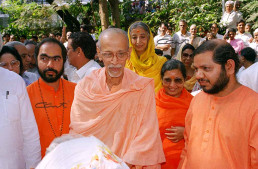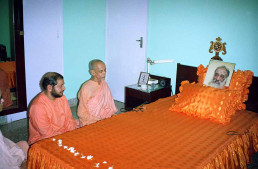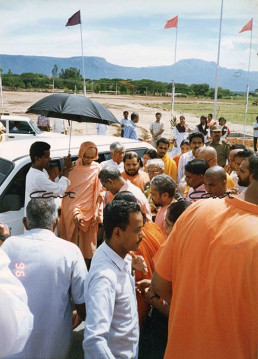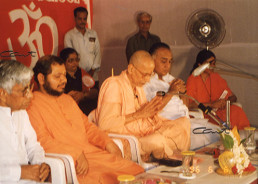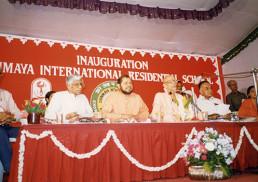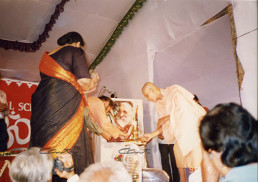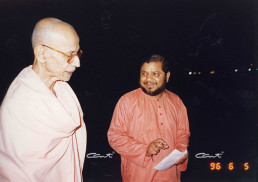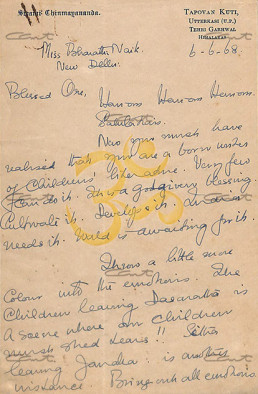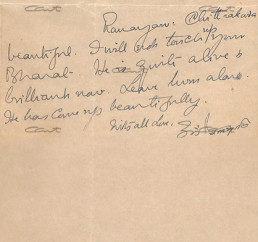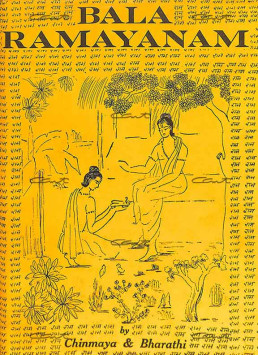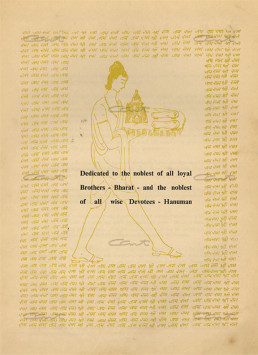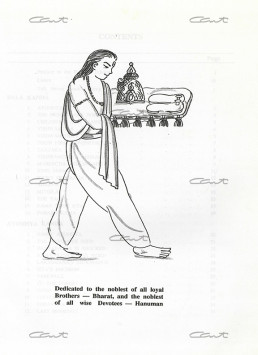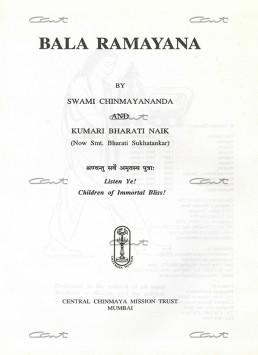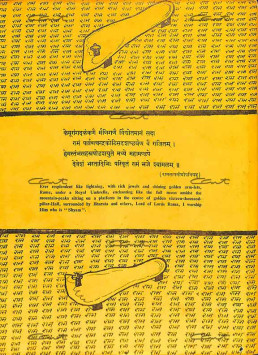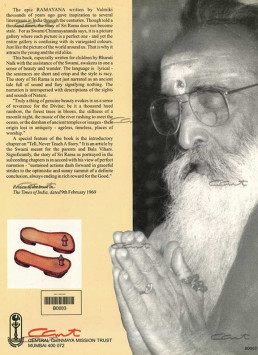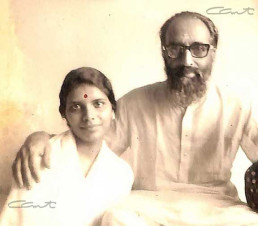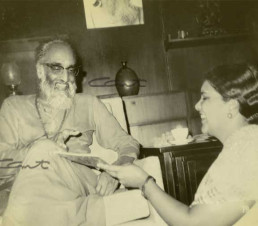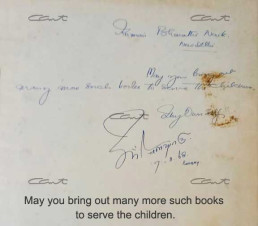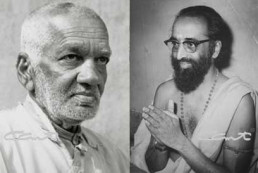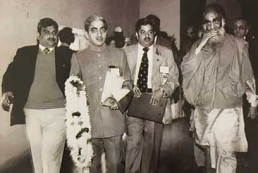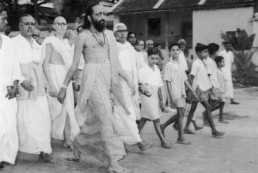Reminiscences
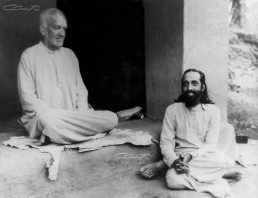
By Swami Chinmayananda
This is an article penned by Pujya Gurudev where he fondly shares some memories of his Guru, Swami Tapovan Maharaj. This article was published in the December 1971 edition of Tapovan Prasad.

By Swami Chinmayananda
This is an article penned by Pujya Gurudev where he fondly shares some memories of his Guru, Swami Tapovan Maharaj. This article was published in the December 1971 edition of Tapovan Prasad.
Here, when I am lying helplessly under treatment in the clinic, my thoughts wander away to Tapovan Kuti on the Ganges banks in Uttarkasi and to the period when I was doing my sadhana there. In this peculiar mood of relaxed memories, many remarkable anecdotes of Sri Gurudev (Swami Tapovanam) explode in my recollections. It is surprising how in my continuous preoccupation with my self-chosen missionary work, I had, all these years, forgotten the brilliant flashes of Sri Gurudev’s ready wit and sparkling wisdom.
I don’t exactly remember the specific occasions that brought up these live examples from him, but each one of them was a glorious answer to some question, or a blazing explanation of some moot point in higher Vedanta.
Once upon a time, described Sri Gurudev, a secular tyrant made a Mahapurusha hang from the branch of a tree by his teeth. Down below flowed the noisy Ganga, smashing her way through a bed of large rocks. At that time a seeker asked, “Sir! Tell me the nature of the Infinite Self.” If the Mahapurusha opened his mouth either to assert or to negate the Self, he would dash himself into the rocky floods; if he remained silent, the student would be neglected, which was against the Mahatma’s sole duty in life. How would he express?
“It is then,” concluded Sri Tapovanam “perhaps, that the Master showed the student the jnana mudra, meaning that the Self is not to be discussed. It is to be realised by oneself in the silence within.” Both assertion and negation are functions of the intellect. Beyond them both is the transcendental Self, the seat of pure Consciousness.
व्यवहार्यमग्राह्यम अलक्षणमचिन्त्यमव्यप-देश्यमेकात्मप्रत्ययसारं प्रपञ्चोपशमं शान्तं
शिवमद्वैतं चतुर्थं मन्यन्ते स आत्मा स विज्ञेयः॥
nāntaḥprajñaṃ na bahiṣprajñaṃ nobhayataḥprajñam na prajñānaghanaṃ na prajñaṃ nāprajñam. adṛṣṭama-
vyavahāryamagrāhyam alakṣaṇamacintyamavyapa-deśyamekātmapratyayasāraṃ prapañcopaśamaṃ śāntaṃ
śivamadvaitaṃ caturthaṃ manyante sa ātmā sa vijñeyaḥ..
It is not that which is conscious of the internal subjective world, not that which is conscious of the external world, not that which is conscious of both, nor that which is a mass of Consciousness, nor that which is simple Consciousness, nor is it unconscious. It is unseen by any sense organ, unrelated to anything, incomprehensible by the mind, uninferrable, unthinkable, indescribable, essentially of the Self alone, negating all phenomena; it is peaceful, all bliss and non-dual. This is what is known as the fourth (turiya). This is the Atman and this is to be realised.1
“A Vedantic teacher was once approached by a mahatma one afternoon,” said Sri Gurudev, “asking him with all reverence, ‘Explain to me, sir, the nature of the Self.’”
“The great master looked at the young monk, winked at him and said, ‘I will tell you all about it when there is no one here.’
“After a time, the anxious and sincere mahatma reached the teacher and reminded him, ‘Now there is nobody here, sir. Please instruct me.’ The Vedantic teacher did not open his eyes, nor did he reply. The mahatma waited for some time, and thinking that perhaps the teacher had not heard, repeated the request.
“The Vedantic saint smiled and said, ‘Not now. Let everyone go away.’
’Sir, everyone has gone; there is nobody here. I am alone here,’ asserted the student.
‘So long as you are here,’ snap came the answer, ‘how can I tell the Truth?’
“Where the ego has ended, and the clamour of all thoughts has been entirely hushed up, in that ‘living-silence’ is the self realised,” concluded Sri Gurudev. I was immature then. From immaturity springs all the audacity of fools. So I asked, “Sir, who is it in the mahatma that knows that there is nobody there?”
Like lightning came the reply: “That, even the wisest do not know.” The vigour and suddenness of the reply then satisfied me. Only now I realise the wisdom of the ready reply. The Self is never an object for anyone’s intellectual appreciation as knowledge.
yato vāco nivartante aprāpya manasā saha
That from which speech and mind return, unable to reach or apprehend — that is the supreme state of the Self.2
Once, a young man came all the way from Sri Gurudev’s native village in Kerala. This man must have rushed out of his home in a moment of economic crisis. However, he had deep devotion and an ardent sense of reverence towards Sri Gurudev. He announced himself as a distant relative of Sri Swami Tapovanam and narrated non-stop the present welfare and well-being of various members of the ‘family’ in Kerala, in its various ‘branches’.
All the time — it was more than an hour — Swamiji sat, listening to the music of the roaring Ganges. Now and then he gave an encouraging and indulgent “Hm… Hm… Hm…” to the young man’s unilateral bombardment.
In the stream of his empty talks, he mentioned his present state of need and poverty. Finally, as an apology for coming without some gift, he said, “What would you say if I came to you empty-handed!”
Snap came the answer from Sri Gurudev, “Drop it down.”
But the noisy speaker, in his incorrigible innocence, went on, “I said, if I came to you really empty-handed?”
The answer shot out from Sri Gurudev, “Then gather and carry away as much you can!!”
When the mouth is noisy, little do we understand what others say, and much less can we comprehend what our mystic masters indicate with their rare words.
The young man understood nothing. He grinned, and Swamiji with a knowing look at me, smiled at the visitor. The visitor was consoled. He must have considered it as some joke Swamiji had cracked, which of course, he could not understand! The young man from Kerala continued his reports of his native village. Swamiji, still smiling, moved his eyes from the visitor to the refreshing flow of the ever-pure mother Gangaji!! Only empty hands can gather and carry away even when given freely by another.
1 Mandukya Upanishad, 7
2 Taittiriya Upanishad, 2.9
Previous Topic
Nothing found.
Next Topic
Nothing found.
Home Page
Nothing found.
One Goal - Many Paths
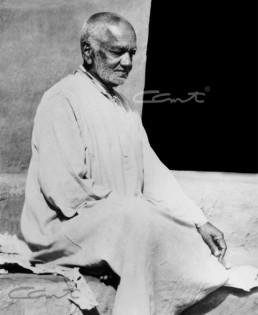
One Goal - Many Paths
This article is a translation from the original manuscript in Malayalam. We thank Smt. Leela Nambiar for giving us permission to access the document and publish it. Our special thanks to Acharya Atma Chaitanya who translated it into English with great care and reverence. We are beholden to Dr. Chidambaram and Dr. Mrs. Kamala Chidambaram for their invaluable help in fine-tuning and editing the translation. The title and the sub-headings have been added by us.
The manuscript makes it clear that it is a commentary on specific slokas. Though the page numbers and sloka numbers are cited (given in the footnotes here), the text is not mentioned. In spite of our best efforts, we have not been able to find out the actual Slokas nor the text where they occur. So, we leave it to the readers to solve this puzzle. We will be very grateful if someone is able to find out and let us know which text is the source for this commentary.

One Goal - Many Paths
This article is a translation from the original manuscript in Malayalam. We thank Smt. Leela Nambiar for giving us permission to access the document and publish it. Our special thanks to Acharya Atma Chaitanya who translated it into English with great care and reverence. We are beholden to Dr. Chidambaram and Dr. Mrs. Kamala Chidambaram for their invaluable help in fine-tuning and editing the translation. The title and the sub-headings have been added by us.
The manuscript makes it clear that it is a commentary on specific slokas. Though the page numbers and sloka numbers are cited (given in the footnotes here), the text is not mentioned. In spite of our best efforts, we have not been able to find out the actual Slokas nor the text where they occur. So, we leave it to the readers to solve this puzzle. We will be very grateful if someone is able to find out and let us know which text is the source for this commentary.
The absolute Truth is only one and not two. In that Reality, there cannot be divisions like sajātiya bheda (differences in the same species), vijātiya bheda (differences between two or more species) and svagata bheda (differences in one given entity). Two independent entities cannot coexist.1 In the world too it is not seen like that. Pot and cloth are not two independent objects. Pot has no domination upon the cloth; similarly, cloth has no domination upon the pot.2 Therefore, these two are dependent as well. Dependent objects are limited by time and space and hence they are perishable. If two entities are accepted to be Real, they cannot have the nature of freedom, existence and imperishability. It is illogical that two entities can both be perishable and also have absolute Reality. Therefore, there cannot be another entity equivalent to the Truth. Hence, it is clear that there can be only one homogenous (akhanda) Reality and it is not compatible with duality. How can a dependent object conditioned by another object be eternal? Thus the Upanishads and the Mahatmas declare that the absolute Truth is non-dual, homogenous and one essence (eka-rasam) which is called Paramātmā (supreme Self) and Isvara (the Lord).
The same Paramātmā assumes forms befitting the temperaments of the devotees, as Vishnu, Krishna, Rama, Siva and Goddess Sakti. The same supreme Self, which is all-pervading and a mass of Existence, Knowledge and Bliss is limited by ignorance and the products of ignorance such as subtle bodies and gross bodies, that is, identifying with them, takes on the jīva-bhāva (of a limited ego). The Vedas declare that this flow of jīva, īśvara and jagat is beginningless and endless. If Brahman and the power of Brahman called mahāmāyā is without beginning and end, its effects as jīva-īśvara-jagat also continue to flow without beginning or end.3
Dropping Our False Identity
The sense of ‘I’ in the body is well-known in Vedanta as ‘superimposition’. Identifying with the body made of flesh and bone, and because of that suffering all kinds of endless miseries, the deluded jīva never gains peace in this world. As long as this very strong delusion of the sense of ‘I’ in the body and the sense of ‘mine’ in those related to the body as wife, children and wealth etc. exist, so long this saṁsāra of the cycle of birth and death will not end.
In order to remove the sense of ‘I’ in the body and the consequent manifold worldly tragedies and to attain the state of supreme bliss, one has to cultivate the sense of ‘I’ in the Self which is one’s own real nature and get established in the knowledge of the Self. The Self has no connection with the body, nor with anything related to the body. Knowing the unattached and changeless Self and revelling in it is mokşa. That alone is the supreme goal parama-puruşārtham.4
The Path of Selfless Action
In order to accomplish the supreme goal which fulfils human birth, the scriptures primarily advise selfless activities and the path of devotion. The householders, in particular, must practise the dedicated performance of self-less action with passionate involvement. Whatever may be the activity, secular or sacred, if performed as worship of the Lord in accordance with one’s capacity, it is known as selfless action – nişkäma-karmam. Selfish actions performed with desire for fruits of action become tainted with desires and lead to saṁsāra (the cycle of births and deaths). Therefore, relinquishing desires completely, with the firm conviction that action is for the sake of action alone, all appropriate actions (according to one’s dharma) should be performed as worship at the feet of the Lord. Thus, when we practice, the mind is gradually relieved of likes, dislikes etc. and becoming free of the thirst for enjoyment, attains purity.5
The Path of Devotion
Among the means for attaining the Lord, the path of devotion is very easy. Continual, constant, intense love of God is called devotion. Even those who are not blessed with great intellectual power and those who are incapable of practising intense spiritual disciplines can also pursue the path of devotion. Love for sense objects needs to be turned towards the Lord alone. To the ordinary seekers desiring attainment of the feet of the Lord, the path of devotion is the best. They should begin to practise devotional exercises. If one can have the same kind of intensity in loving the all-compassionate Lord as worldly people have towards their wife and children – once such intense devotion has risen – then what else is there to be gained in this world? Having practised the means of devotion through actions like japa, singing His glory, listening, meditation etc. for a long time, when firm devotion rises in the mind, it leads to direct realisation of God. A devotee can realise the Lord either with form or without any form.6
The Path of Aștānga Yoga
Prāņāyāma and practice of yoga exercises is also one of the means for God-realisation. Since it is not possible to realise the essence of Brahman without purity and control of mind, need it be mentioned separately that the practice of yoga, which is a form of mental restraint, is very useful for the realisation of God? One should practise the paths suited to one’s nature. With the control of prāna, mental restraint can be achieved gradually. Without the practice of yama, niyama, viveka and vairāgya, mere practice of prāņāyāma and some āsanas will not help in gaining liberation or realising the truth about the Lord. All these bodily exercises are only like the physical exercises of school students, but they will not help to attain the Self, much less gain the restraint of mind which is the means for Realisation. Therefore the eight steps in yoga (asțänga) have to be sequentially practised to attain mastery. Without these, the pūraka and kumbhaka of fools who are desirous of worldly pleasures and devoid of the desire for liberation become a matter for laughter and mockery. Those yogis should be known as brothers of fishermen who also do kumbhaka (control of the breath) while diving to catch fish. Prāņāyāma without yama and niyama is a waste.
Conclusion
Thus each one, according to his innate nature, has to pursue firmly one of the paths – selfless activities, devotion or yoga. This will help to cleanse the mind and make it pure and single-pointed, rendering it capable of contemplating on the changeless Brahman and realising it. Thereafter, through analysis of the essence of Truth, it is possible to attain the vision of the Truth easily. Realisation of the Truth is not far away for the mind thus qualified by pursuing these practices. Therefore, one has to continue efforts for a long time with great enthusiasm in karma yoga, bhakti and yoga. In this way, the mind having become pure and single-pointed, one realises the formless, attributeless, transcendental Truth and attains the state of kaivalya.7
1 An independent entity here refers to an entity which is not limited or conditioned by other entities.
2 The word ‘domination’ here seems to refer to pervasiveness. The pot does not pervade the cloth. In fact, it is limited by the very existence of the cloth. So also with the cloth which is limited by the existence of the pot.
3 Page 317, Slokas 8, 9 and 10
4 Page 318, Slokas 11 and 12
5 Page 331, sloka 74
6 Page 333, slokas 83 & 84
7 Page 337, slokas 101 & 102
Previous Topic
Nothing found.
Next Topic
Nothing found.
Home Page
Nothing found.
Light of the Himalayas
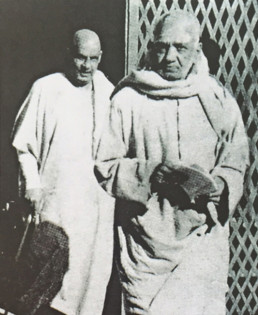
The Light of the Himalayas
This article by Swami Sivananda was originally published in a Shraddhanjali Souvenir brought out in 1958 by Sri P. Krishnan Pillai (Swami Mahadevavanam) to commemorate the first anniversary of the mahasamadhi of Swami Tapovan Maharaj. This article had an interesting byline in the original publication: “Here is an article by the ‘Lion of the Himalayas’ on Swami Tapovanam, ‘The Light of the Himalayas’.”

The Light of the Himalayas
This article by Swami Sivananda was originally published in a Shraddhanjali Souvenir brought out in 1958 by Sri P. Krishnan Pillai (Swami Mahadevavanam) to commemorate the first anniversary of the mahasamadhi of Swami Tapovan Maharaj. This article had an interesting byline in the original publication: “Here is an article by the ‘Lion of the Himalayas’ on Swami Tapovanam, ‘The Light of the Himalayas’.”
It is indeed a matter of pleasure for me to write about the life and achievements of the late Sri Swami Tapovanji Maharaj with whom I lived closely, observing his way of life. There were times when we used to go together to the kshetra for bhiksha and spend time discussing the problems of philosophy. It was a pleasure to observe his novel ways, convincing explanations, his peculiar style of speaking in Hindi and his innocent laughter at times. He was a great virakta1 who is known as such throughout the Uttara Khand. Most of his life he spent in seclusion, scriptural study and meditation. His love of nature, which he so marvellously expressed through his poetry in Sanskrit, was something unique. The Himalayan birds with their beautiful plumage and the simple ordinary flowers received his special notice, the fine descriptions of which are to be found in his Ishwara Darshanam and other works.
Predominantly, His Holiness was a philosopher of the Eastern type, at once practical and prudent. He refused to swerve from his idea even under the most tempting and critical times. His supreme reverence for the Upanishads and the Acharyas could not but impress every aspirant. When such matters used to be brought in for discussion, he would be all enthusiasm and bliss. He insisted on the equipment2 of spiritual aspirants and taught only the qualified seekers (adhikaris).
He has been acclaimed as one of the great Sanskrit scholars of the times. His command of prose and poetry was surprising even to scholars. His lofty feelings and pleasant emotions found effective expression in his volumes. Even in Malayalam, he could write with the same elegance and ease. He was a great critic of literature. In matters of everyday life too, he used to be critical and logical. He was a widely read saint. Many of my works in English and in Hindi were perused by him. At times he used to give his opinion and pass his judgement on the worth of the works. He liked me immensely, even as I did him. Our friendship never slackened. The pleasant memories of events that took place when we both spent our earliest period at Rishikesh are still green in my mind.
Sri Tapovanamji Maharaj was a great conversationalist, whose talk could appeal to all kinds of people, young and old, men and women, laymen and sannyasins. Unless asked to clear philosophical doubts, he refrained from talking on such matters, but would engage the visitors in talk about day-to-day affairs. In this he was unique. Very little reference to his own glorious life could be found in his conversation. His own autobiography appears more like a biography, as if it were written by a close disciple of his! Name he avoided; fame he shunned. Prominence and prestige were anathema to him, and he felt insulted whenever they were forced on him. Such was his indifference towards worldly things.
Great men are simple in their ways and behavior. Tapovanamji was simple in his dress and lived in an ordinary kutir. He was content with the obtainment of the bare necessities of life. He could easily command any comforts and facilities, but he preferred to lead an unassuming life of utter simplicity. He shunned the Mandaleshwarship offered to him. Spiritual aspirants get inspiration from his life and teachings. His last words to the devotee who served him were, “Do not get entangled in bhranti3, i.e. worldly samsara. I led a life of virakti till the end of my life and I am happy.” Equally significant was the statement which he made when some of the devotees wished to take him to Delhi for treatment. “I do not want to go to Delhi. Do not even ministers die in Delhi? Are not people dying by the thousands in England and Washington? It is immaterial whether one dies three days earlier or three days later. I came to Uttarkasi to throw the body into the Ganges.” Here is the wisdom of a saint who cannot be carried away by the urgencies of the time and need, but sticks to his ideal at any cost. Glory to such a mighty soul!
A man of Self-realisation does not stand in need of defining God. He is beyond doubt and disbelief, argument and discussion. He cannot be disturbed by the happenings of the external world. His mind is ever balanced and steady. He is certain about the nature of the Truth which is at once transcendent and immanent, unborn and eternal. Experience and silence characterise his life. So Swami Tapovanamji did not countenance useless wrangling. Shantoyamatma – this Atman is silence.
A beacon-light of Uttara Khand, a torch-bearer of wisdom, guide to the seeker after Truth and a light for the Himalayas, His Holiness spent over thirty years in Uttarkasi and Gangotri; occasionally he used to come down to Rishikesh in winter for giving darshan and upadesha to the thirsting devotees. Many aspirants, both lay and sannyasin, knew him and they used to derive inspiration from him. His departure is a real irreparable loss to the spiritual world. But he is not gone anywhere. To the discerning ones, he is everywhere as the immortal Atman. Let us pray for him. He was a jivan-mukta and now he is a videha-mukta; therefore there is no need for our praying for him, yet we would like to offer our homage to him.
Glory to the Brahma-vidya Gurus!!
1 Detached and dispassionate person, a renunciate
2 Equipped with qualities like the sadhana chatushtaya
3 Delusional
Previous Topic
Nothing found.
Next Topic
Nothing found.
Home Page
Nothing found.
Homage to Sri Swami Tapovanam
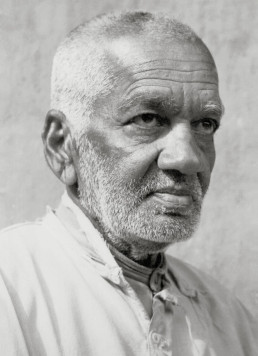
Introduction
The 50th anniversary edition of Tapovan Prasad (December 2011) was entirely dedicated to our Paramaguru Swami Tapovan Maharaj. It is a treasure trove of prose and poetry from Swami Tapovanam’s pen, as well as reminiscences by Pujya Gurudev and others. In this section of the website we have reproduced some of those articles for the benefit of our readers today and for generations to come.
Select an article below.
Nothing found.
Related Topics
Nothing found.
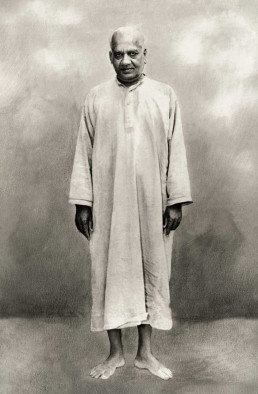
Introduction
The 50th anniversary edition of Tapovan Prasad (December 2011) was entirely dedicated to our Paramaguru Swami Tapovan Maharaj. It is a treasure trove of prose and poetry from Swami Tapovanam’s pen, as well as reminiscences by Pujya Gurudev and others. In this section of the website we have reproduced some of those articles for the benefit of our readers today and for generations to come.
Nothing found.
Related Topics
Nothing found.
Guru-Bhais
INTRODUCTION
His Holiness Swami Sivananda Maharaj was known to have produced many Saints and Sages. Two of them in particular would become Guru-bhais who went their own ways but shared an inseparable bond.
BALAKRISHNAN MENON
P.B.K. Menon a journalist by profession, was curious to know what an ashram life was like. On the one hand he wanted to expose the lives of the Sadhus, but at a deeper level, he was eagerly thirsting to meet his saviour and unknown Master. He had read about Swami Sivananda and thus reached the Divine Life Society.
Menon stayed on for two-three months, fascinated by Swami Sivananda’s divinity, love and teachings. The death of his close friend Narendra Shroff made his disenchantment with the world complete. He moved to Ananda Kutir for good, to follow the spiritual path, to study and serve Swami Sivananda.
SANNYASA DIKSHA
On February 25th, 1949, Maha Shivratri day, he was initiated into the holy order of Sannyasa by Swami Sivananda, and was ordained Swami Chinmayananda Saraswati.
Swami Sivananda then guided the disciple to the most renowned Vedanta master of the time, Swami Tapovanam, under whom he underwent a period of intense study and austere living.
SRIDHAR RAO
Born: Sep 24, 1916
Right from his young age Sridhar Rao was spiritually inclined. He was exposed to the Puranas. Doing Tapas, becoming a Rishi, and having a vision of the Lord became ideals which he cherished. Although born in a wealthy family, he shunned the pleasures of the world to devote himself to seclusion and contemplation.
Charity and a strong desire to serve the sick and needy, were deeply ingrained in him. He was known for his incessant service to those in need. Not just humans but even birds and animals claimed his attention.
As he grew, his spiritual thirst only increased. By 1943 he was already in communication with Swami Sivananda, who gave him permission to join the Ashram.
GURU SEVA
Very soon after joining the Ashram, he gave ample evidence of the brilliance of his intellect. Soon he took charge of the dispensary, delivered lectures, wrote articles including a biography of Swami Sivananda, established the Yoga Museum, all while intensifying his Sadhana.
In just 5 years, Swami Sivananda made him the General Secretary of the Divine Life Society.
SANNYASA DIKSHA
On Guru Purnima day July 10, 1949, he was initiated into the holy order of Sannyasa by Swami Sivananda, who ordained him Swami Chidananda.
Swami Chidananda worked and served the cause of Swami Sivananda’s mission tirelessly, and spread his Divine Life message far and wide, globally.
AT DIVINE LIFE SOCIETY
Photographs of these soon-to-be spiritual giants as they studied and served Swami Sivananda Maharaj.
Photographs of these soon-to-be spiritual giants as they studied
and served Swami Sivananda Maharaj.
The two Guru-bhais went their separate ways, but the bond they shared knew no physical or geographical borders.
The two Guru-bhais went their separate ways, but the bond they shared knew no physical or geographical borders.
JNANA YAJNAS
Swami Chinmayananda started the Upanishad and Gita Jnana Yajnas in 1951 and went on to become the founder of Chinmaya Mission, spreading its wings around the world in order to bring the message of the Vedanta to us.
DIVINE LIFE
After the mahasamadhi of Swami Sivananda, Swami Chidananda would become the President of Divine Life Society, to carry on the work of his illustrious Guru. He traveled all over India and the globe to spread the message of Divine life.
Despite their very busy schedules, whenever an opportunity presented itself, both the Mahatmas made full use of it.
SURPRISE IN DUBAI
Pujya Gurudev was addressing an audience in Dubai. Swami Chidananda also happened to be visiting at that time. He asked his host to take him to the venue where he quietly sat in the last row to enjoy the talk of his spiritual brother. Pujya Gurudev noticed his presence, paused and said: When the sun rises, the stars have to fade.
He escorted Swami Chidananda to the stage and announced: Now I introduce you to the real sun (and son) of Swami Sivananda. Whatever time he allots to you, you can bask in his sunshine.
SURPRISE IN DUBAI
Pujya Gurudev was addressing an audience in Dubai. Swami Chidananda also happened to be visiting at that time. He asked his host to take him to the venue where he quietly sat in the last row to enjoy the talk of his spiritual brother. Pujya Gurudev noticed his presence, paused and said: When the sun rises, the stars have to fade.
He escorted Swami Chidananda to the stage and announced: Now I introduce you to the real sun (and son) of Swami Sivananda. Whatever time he allots to you, you can bask in his sunshine.
IN ORISSA, 1984
In 1984 Swami Chinmayananda was in Bhubaneshwar for a 10-day Yajna. One day, despite his always packed schedule, he asked for a car and driver and left without disclosing his destination.
Returning in time for the Yajna, he was beaming with joy. When asked where he had gone, he said: I was with my dear friend Swami Chidananda. I went to visit his new ashram land in Orissa. He was referring to Chidananda Hermitage, Shanti Ashram – Divine Life Society, Orissa.
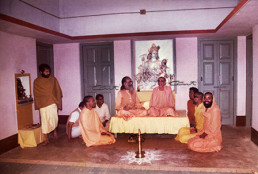
INAUGURATION OF CHINMAYA VIDYALAYA
Swami Chidananda's speech
In October 1991, Swami Chidananda was invited to inaugurate the auditorium at Chinmaya Vidyalaya, Tirunelveli. Here, Swami Chidananda paid rich tributes to Swami Chinmayananda, hailing him as the “the Kohinoor of Bharatavarsha, a torch bearer of Vedanta.”
Swami Chidananda referred to Swami Chinmayananda as his “beloved and worshipful spiritual brother.” This speech radiates the pride and affection Swami Chidananda had for Pujya Gurudev.
MEETING IN TIRUNELVELI, JANUARY 1993
Dr. Shailaja Nadkarni remembers this meeting vivdly.
During Pujya Gurudev’s yajna in January 1993, at Tirunelveli, Swami Chidananda was passing through the town. He came on the inaugural day of the yajna and the Guru-bhais met at the Ganesha temple in Chinmaya Vidyalaya, the venue of the yajna. No words were exchanged, just a sweet meeting in silence. When Mahatmas meet, the silence is rich in communication. Words are redundant.
The two Guru-bhais were born within a few months of each other. In one of his last letters to Swami Chidananda, Swami Chinmayananda wrote, “Now we are on a neck-to-neck race; let’s see whose time comes first.”
THE HOSPITAL, SAN DIEGO
“Guru is never critical. Do not use that word. Whoever had a glimpse of Swami Chinmayananda had total Ishwar Darshan in their lives. Take off your shoes and go to the third floor and bask in the presence of Brahman.”
These were the words of Swami Chidananda to Dr. Shailaja Nadkarni at the hospital where Swami Chinmayananda was admitted after suffering a massive heart attack.
HELP IN TRYING TIMES
When Gurudev attained mahasamadhi, devotees were devastated. They did not know of the procedures, as this was a totally new experience for all of them, as well as the young Swami Tejomayananda. Swami Chidananda guided Swami Tejomayananda about the rituals and the last rites to be performed. Under his instructions, Pujya Gurudev’s body was kept in a sitting posture. The last rites were also conducted with his guidance. He deputed one of the senior Swamis of Divine Life Society to attend the final rituals at Sidhbari.
Below: Swami Chidananda blesses Swami Tejomayananda at the hospital in San Diego in July 1993.
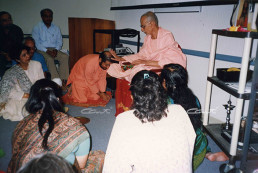

PARLIAMENT OF THE WORLD'S RELIGIONS
In the year 1993, the second Parliament of the World’s Religions was held from August 28 to September 4. Swami Chinmayananda was selected as the President of Hindu Religion and asked to lead a delegation of sixty practitioners of Hindu religion. However, he fell ill and requested Swami Chidananda to lead the delegation on his behalf. As Swami Chinmayananda attained mahasamadhi on August 3, 1993, Swami Chidananda was made President instead.
Swami Vimalananda who became the president of Divine Life Society after Swami Chidananda, recollects those times.
SAMADHI STHAL
The relationship between the two Mahatmas continued even after the mahasamadhi of Swami Chinmayananda. Swami Chidananda had come to Sidhbari in 1994 to attend the first mahasamadhi anniversary of Swami Chinmayananda. While he took a parikrama around the Samadhi Sthal he said, “A bit of Swami Chinmayananda is in the hearts of each one of his devotees, without exception.”
STATUE INAUGRATION
On 12th February, 1995, Pujya Gurudev’s pratima was installed in Sandeepany Sadhanalaya, Mumbai. Swami Chidananda unveiled the statue.
Swami Chidananda at the Inauguration of CIRS
Chinmaya International Residential School
Swami Tejomayananda fulfilled Swami Chinmayananda’s vision of establishing the Chinmaya International Residential School (CIRS) at Coimbatore in 1996. It was but natural that Swami Chidananda was invited as chief guest at the inauguration of the school. In his speech on that day, Swami Chidananda announced that Pujya Gurudev himself was present for the function to shower his blessings. He revealed to the astonished audience that his train ticket was booked under the name of Swami Chinmayananda quite inadvertently!
A CHILDHOOD SONG
In 2004, more than a decade after Pujya Gurudev’s mahasamadhi, Swami Chidananda went into retreat at Dehradun. One day, probably when he was thinking about his Guru-bhai, a song flashed in his mind, one that Swami Chinmayananda had learnt from his mother in his childhood. Gurudev had shared this song with him in their early years.
Much as he tried, he could not recollect some of the lyrics of the song that was in Malayalam. Swami Padmanabhananda recalls the incident which showed how much the two Guru-bhais meant to each other.
SWAMI TEJOMAYANANDA REMEMBERS
After the mahasamadhi of Swami Chidananda, when Swami Tejomayananda was invited to DLS. There he recalled “He used to refer to me as his spiritual nephew.” Since Swami Tejomayananda was Swami Chinmayananda’s disciple, like a son and Swami Chidananda was Swami Chinmayananda’s Guru-bandhu, Swami Chidananda was spiritual Uncle to Swami Tejomayananda.
In that speech Swami Tejomayananda affectionately remembered the timely assistance that Swamiji Chidananda was of, when Pujya Gurudev attained mahasamadhi.
GLORIFYING GURUDEV'S WORK
When Swami Swaroopananda met Swami Chidananda in Hong Kong, Swami Chidananda spoke very highly of Pujya Gurudev and glorified his work. In Swami Swaroopananda’s words, “Hearing from another master the greatness of your Master was wonderful.” Referring to Gurudev, Swami Chidananda emphasized that there was no one like him who had single-handedly spread the knowledge of Bhagavad Gita among the masses. He said that it was no ordinary work and it could not be done by any ordinary person.
Even after Swami Chidananda attained mahasamadhi in August 2008, the two organizations continue to reflect the loving bond between the two Guru-bhais. Swami Tejomayananda and Swami Swaroopananda have the highest regard for the work being done by the Divine Life Society. Swami Vimalananda and Swami Padmanabhananda of Divine Life Society have extended their help to Chinmaya Mission in many ways. We acknowledge the contribution of Divine Life Society with immense gratitude. Our special thanks to Brahmanishta Mathaji for her gracious assistance with material from DLS.
Even after Swami Chidananda attained mahasamadhi in August 2008, the two organizations continue to reflect the loving bond between the two Guru-bhais. Swami Tejomayananda and Swami Swaroopananda have the highest regard for the work being done by the Divine Life Society. Swami Vimalananda and Swami Padmanabhananda of Divine Life Society have extended their help to Chinmaya Mission in many ways. We acknowledge the contribution of Divine Life Society with immense gratitude. Our special thanks to Brahmanishta Mathaji for her gracious assistance with material from DLS.
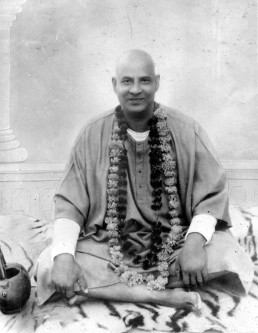
Swami Sivananda
I have produced few dozens of saints and sages who are the King of Kings & emperor of emperors and they are spread across all over the world. My teachings are summarised in six words: Serve, Love, Give, Purify, Meditate, Realize. I serve all. I love all. I see The Lord in All.
Making of Bala Ramayana
INTRODUCTION
A young Bharati Naik (now Sukhatankar) had met Gurudev in 1968 during the Delhi Yajna. Enthralled by what she witnessed during the Yajna, she wrote a six-page letter to Gurudev a few days later, seeking guidance on how to apply in life all the knowledge that he had poured out in the Yajna.
Gurudev’s reply came promptly. "Write a Bala Ramayana for children.”
Bharati was taken aback. She was a science major. “Why would he ask me to write, and that too a Ramayana for children? “ she wondered, thinking he was mistaken.
Bharati Interview Clip 1
THE BEGINNING
24th April 1968
I am sending you a new Ramayana that I got. Read it carefully and pass it all on to the children.
You must rewrite that book, with details taken from Rajaji’s Ramayana --- which is yet another simple text, and thus prepare a Ramayana for our Mission children. Take your own time.
Glorify Bharat’s character more than Rama's.
A NOVICE
Bharati had no prior experience as a writer or working with children. But she studied the epic meticulously and then began writing, sending him 20-25 pages of manuscript at a time.
Gurudev’s reply was prompt and very encouraging.
A NOVICE
Bharati had no prior experience as a writer or working with children. But she studied the epic meticulously and then began writing, sending him 20-25 pages of manuscript at a time.
Gurudev’s reply was prompt and very encouraging.
A HELPING HAND
6th June 1968
Now you must have realised that you are a born writer of children’s literature. Very few can do it. It is a god-given blessing. Cultivate it. Develop it. India needs it. World is awaiting for it.
Throw a little more colour into the emotions. The children leaving Dasaratha is a scene where our children must shed tears!! Sitha leaving Janaka is another instance. Bring out all emotions vividly. Let them weep in sympathy, love, affection, tenderness, devotion, obedience; Sigh in relief, heave in the heroism felt, courtesy shown, goodness manifest.
It is in these deep reactions that children get these qualities ever fixed upon their heart.
FRIENDLY ADVICE
These are suggestions not criticisms. Now you must consider me as an old old friend of yours talking to you with my arms around your shoulders!! Else you will understand that I am dictating my criticism.
Careful. Human mind is a wretch. We don’t know when it will misinterpret the best of your experiences.
FRIENDLY ADVICE
These are suggestions not criticisms. Now you must consider me as an old old friend of yours talking to you with my arms around your shoulders!! Else you will understand that I am dictating my criticism. Careful. Human mind is a wretch. We don’t know when it will misinterpret the best of your experiences.
SKETCHES
As she wrote the story, Bharati would draw some sketches of the characters just for her amusement. She happened to send them along with the manuscript to Gurudev.
Gurudev was very pleased.
It is a boon that you are so very good at sketches. We need only sketches - Crayon or Indian - ink. Let us have it full page and book printed in big types too.
Bharati Interview Clip 2
BHARATI RECOLLECTS
It took all of two months to write the book. Manuscript and feedback were exchanged almost every day. There were times when I was quite overwhelmed by his guidance and appreciation. “I have returned yesterday the Ayodhya khand, with the pages dirtied by my honest tears! Your pen knows how to draw them out!!”
I was taken aback and read those pages again. They were about Shri Rama leaving Ayodhya for the forest.
Bharati Interview Clip 3
BHARATI RECOLLECTS
It took all of two months to write the book. Manuscript and feedback were exchanged almost every day. There were times when I was quite overwhelmed by his guidance and appreciation. “I have returned yesterday the Ayodhya khand, with the pages dirtied by my honest tears! Your pen knows how to draw them out!!”
I was taken aback and read those pages again. They were about Shri Rama leaving Ayodhya for the forest.
Bharati Interview Clip 3
INSPIRING WORDS
16th June 1968
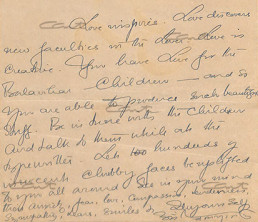
Love inspires. Love discovers new faculties in the lover. Love is creative. You have love for the Balavihar children --- and so you are able to produce such beautiful stuff. Be in tune with the children and talk to them while at the typewriter. Let hundreds of innocent chubby faces be uplifted to you all around. See in your mind their anxiety, fear, love, compassion, tenderness, sympathy, tears, smiles and Thy own Self.

INSPIRING WORDS
16th June 1968
Love inspires. Love discovers new faculties in the lover. Love is creative. You have love for the Balavihar children --- and so you are able to produce such beautiful stuff. Be in tune with the children and talk to them while at the typewriter. Let hundreds of innocent chubby faces be uplifted to you all around. See in your mind their anxiety, fear, love, compassion, tenderness, sympathy, tears, smiles and Thy own Self.
APPLAUSE
20th June 1968
You have brought out the mighty character of chaste Bharath. Good. If I have 4 hands I would have applauded with all the four --- Okay: you have 2 hands: now you applaud there and here I will also do.
You go on writing exactly as you are now writing and show the manuscript to none. Let us compile the manuscript complete. Then we shall show them the proof copy from the Press!!
2 DAYS LATER
Ramayan: Chittrakoota beautiful. I will not touch up your Bharat. He is quite alive and brilliant now. Leave him alone. He has come up beautifully.
APPLAUSE
20th June 1968
You have brought out the mighty character of chaste Bharath. Good. If I have 4 hands I would have applauded with all the four --- Okay: you have 2 hands: now you applaud there and here I will also do.
You go on writing exactly as you are now writing and show the manuscript to none. Let us compile the manuscript complete. Then we shall show them the proof copy from the Press!!
2 DAYS LATER
Ramayan: Chittrakoota beautiful. I will not touch up your Bharat. He is quite alive and brilliant now. Leave him alone. He has come up beautifully.
ADVICE FOR LIFE
26th June 1968
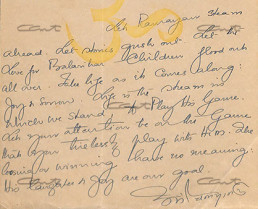
Let Ramayan steam ahead. Let stories gush out. Let the love for Balavihar children flood out all over. Take life as it comes along: joy and sorrow. Life is the stream, in which we stand to play His game. Let your attention be on the game that you tirelessly play with Him. The losing or winning have no meaning. His laughter and joy are our goal.

ADVICE FOR LIFE
26th June 1968
Let Ramayan steam ahead. Let stories gush out. Let the love for Balavihar children flood out all over. Take life as it comes along: joy and sorrow. Life is the stream, in which we stand to play His game. Let your attention be on the game that you tirelessly play with Him. The losing or winning have no meaning. His laughter and joy are our goal.
FINE TUNING
27th June 1968
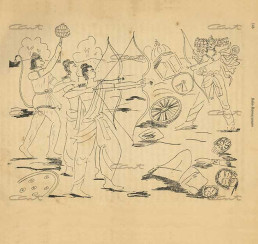
In a hurry-bury don’t kill Ravana - #1 : A criminal like him must die slowly. Sudden death is a blessing. #2: Ravana was a tapaswin. He had acquired many blessings from the Lord and therefore, in your hurry-bury if you kill him only half, he will get up with a vengeance in your bosom again with all the ten heads efficiently working to destroy all the good in the bosom.
In that section, please go a little slow, painting thick the incorrigible devil in Ravana - uncompromising, unrepenting, with inhuman audacity and vicious purposefulness. When the disease is serious, acute, treatment is to be very thorough. Slowly paint how, in the agony of his death, vanity in him gets slowly dripped out, until at last he realises his folly. Show the sense of justice in Rama in honoring and respecting his great enemy.
FINE TUNING
27th June 1968
In a hurry-bury don’t kill Ravana - #1 : A criminal like him must die slowly. Sudden death is a blessing. #2: Ravana was a tapaswin. He had acquired many blessings from the Lord and therefore, in your hurry-bury if you kill him only half, he will get up with a vengeance in your bosom again with all the ten heads efficiently working to destroy all the good in the bosom.
In that section, please go a little slow, painting thick the incorrigible devil in Ravana - uncompromising, unrepenting, with inhuman audacity and vicious purposefulness. When the disease is serious, acute, treatment is to be very thorough. Slowly paint how, in the agony of his death, vanity in him gets slowly dripped out, until at last he realises his folly. Show the sense of justice in Rama in honoring and respecting his great enemy.

THE FINAL STRETCH
As he was editing the manuscripts Gurudev was simultaneously working with publishers and printing houses to meet a tight schedule and an even tighter budget. Here are some snippets sourced from his letters to Bharati.
THE FINAL STRETCH
As he was editing the manuscripts Gurudev was simultaneously working with publishers and printing houses to meet a tight schedule and an even tighter budget. Here are some snippets sourced from his letters to Bharati.
Title
Should we change it to: A) BALA RAMAYANA or B) BALA VIHAR - RAMAYANA.
In case of B. we can repeat as BALA VIHAR - BHAGAWATHAM, BALA VIHAR - STORIES, BALA VIHAR - HISTORY etc.
Cover
Nowadays coloured cover is not in fashion. Only simple black and white stroke picture is on the run. If you can do one of Bharat with Paduka: or Rama and Sitha in front of their Parnasala in Chitrakoot, occupying only 3/4th of the page in height with space for the Title it will be nice.
I am glad you liked the idea of Ram Ram Ram Ram Ram Ram Ram Ram on the dust-cover.
Printing
I am not keeping quiet. I am at it. One of the estimate got is book of 11” x 8 ½” - about 200 pages Show board both sides, open binding, dust cover, etc - for 5000 copies --- Per book Rs. 4-43 using offset paper 36 lbs (Ballarpur). This is a bit on the big side but they can give us only in 6 months.
Let them find out Ms/ bulk or tell them it is in 169 full-scap double-space typed matter with 31 full page blocks. We want it via slightly bigger type set. So it will be sure 200 - 250 pages. Let him get estimate and an assurance that delivery is by October 27th (1968) at Bombay first 1000 copies.
Decision
I am accepting quotation of Hoe & Co. Thompson Press rejected. 1) Late 2) quotation contains neither sample of paper, nor sample of types. No time for replying. We will get the books ready by October. I am sending dust cover design from here directly to Madras.
BLESSINGS
17th July 1968
As the project neared completion, Gurudev showered his blessings on Bharati, while sharing his plans for their next book together: BALA BHAGAVATA
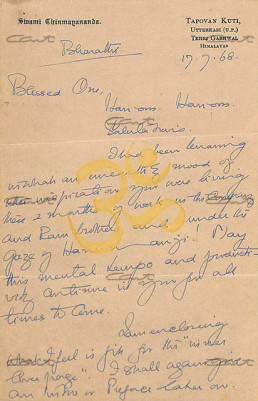
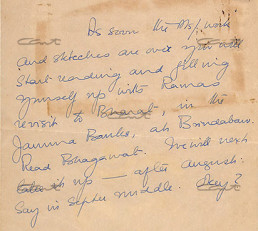
I had been knowing in what an unearthly mood of utter inspiration you were living these 2 months of work in the company and Ram brothers and under the gaze of Hanumanji! May this mental tempo and productivity continue in you for all times to come.
I am enclosing what I feel is fit for the “inner cover page”. I shall again give an intro or preface later on.
As soon as the Ms/ work and sketches are over you will start reading and filling yourself up with Rama’s revisit to Bharat, in the Jamuna Banks, at Brindaban. Read Bhagawat. We will next take it up --- after August: Say in September middle? Okay?
BLESSINGS
17th July 1968
As the project neared completion, Gurudev showered his blessings on Bharati, while sharing his plans for their next book together: BALA BHAGAVATA
I had been knowing in what an unearthly mood of utter inspiration you were living these 2 months of work in the company and Ram brothers and under the gaze of Hanumanji! May this mental tempo and productivity continue in you for all times to come.
I am enclosing what I feel is fit for the “inner cover page”. I shall again give an intro or preface later on.
As soon as the Ms/ work and sketches are over you will start reading and filling yourself up with Rama’s revisit to Bharat, in the Jamuna Banks, at Brindaban. Read Bhagawat. We will next take it up --- after August: Say in September middle? Okay?


A CAREER IN WRITING
Bharati and Gurudev
Bharati would soon complete the Bala Bhagavata and go on to produce many more books for children including Tell me a Story and The Balavihar Books of Hanuman Chalisa, Picture Parables, Gurudev's Tales, Jokes, Fun and Facts and Jungle Jingles. She has been the editorial advisor of Balavihar, our international magazine for children, for more than two decades. Bharati has also re-edited many books under Gurudev's watchful eyes, including Vivekachudamani, almost all of Gurudev's commentaries on the Upanishads, the Holy Geeta, Hymn to Badrinath and Ganga Stotram. She is another great testament to Gurudev's innate ability to see potential in a person and bring it out to the fullest.
Love For Guru
Pujya Gurudev revered, adored and worshipped his Guru, Parama Pujya Swami Tapovan Maharaj. “All my life is a story of my love for him,” said he in a moment of quiet reverie. In every yajnasala, the picture of Swami Tapovan Maharaj would adorn the altar on the dais and smile his benign blessings as his disciple quoted and explained, reasoned and cajoled, proclaimed and roared the truth of the scriptures from the vyasa peeth.

And all the adulation he received was passed on meticulously to his Guru in an act of mental surrender. In fact, he would teach his students, the future acharyas, how to accept the prostrations of the devotees gracefully and pass them on to the Lord or to the Guru, so that there is no chance for the ego to get fattened!
The last few years of Swami Tapovanam's bodily life.

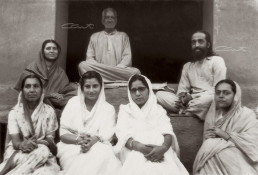
By the end of 1955, Swami Tapovan Maharaj's health began to deteriorate. It was a trying time for Gurudev and he visited Uttarkashi as often as possible in between the jnana yajnas. He kept up a regular correspondence and sent medical help.
In a letter dated September 9, 1955, Pujya Gurudev writes to Shakuntala Bindra:

I must hurry to Gangotri. I had a note from Swamiji Maharaj which read that he is feeling weak and fatigued though not ill. Such a statement cannot easily come from his lips unless he is feeling really bad. I must hurry up to meet him.
Gurudev felt that Swami Tapovan Maharaj needed to be hospitalized, but the Guru who was an embodiment of equanimity refused:

Are there not people dying in London, in New York, and in Delhi with all the best facilities for diagnosis and treatment? Then why should I not end my life in peace amidst the Himalayas where I have lived for so many years?
Chinmaya, you go and continue the work …
On June 22nd 1956 Swami Tapovanam wrote this letter to Gurudev.
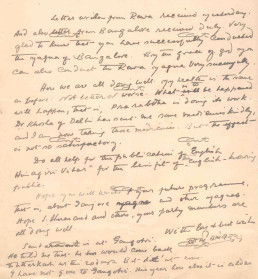
Letter written from Rewa received yesterday. And also letter written from Bangalore received duly. Very glad to know that you have successfully conducted the yagna of Bangalore. By the grace of God you can also conduct the Rewa yagna very successfully.
Here we are all doing well. My health is the same as before. Not better or worse. What is to happen will happen, that is, prarabdha is doing its work. Dr. Khosla of Delhi has sent me some medicines kindly, and I am now taking those medicines. But the effect is not so satisfactory.
Do all help for the publication of English “Himagiri Vihar” for the benefit of the English knowing public.
Hope you will write your future programme, that is, about Tanjore and other yagnas. Hope S. Atmanand and others, your party members are doing well.
Sundaranand is at Gangotri. He told me that he would come back to Uttarkashi within twenty days. But didn’t come. I have not gone to Gangotri. This year here also it is cold now.
With love and best wishes,
Swami Tapovanam
Then came a telegram dated 18th January, 1957, informing him of Swami Tapovan Maharaj's mahasamadhi on the 16th morning.
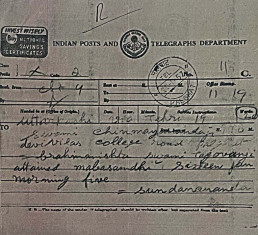
Uttarkashi-via-Tehri
Swami Chinmayanandaji,
Devi Vilas, College Road, Palghat
Brahmanishta Swami Tapovanji attained mahasamadhi sixteenth January morning five.
– Sundarananda
A letter to Sheela Sharma, written by Pujya Gurudev soon after he received the telegram, reflects his distraught state of mind in his handwriting:

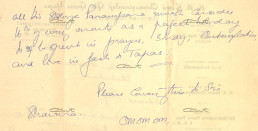
Just received a wire informing that on Jan 16th morning 5 AM Sree Gurudev has attained Mahasamadhi. I feel suddenly that I have become an orphan physically. Spiritually I have grown in my strength and power today.
He has left his particular form. But he now lives in each one of us. Let us nurture and nourish Him and bring Him out through each one of us. I feel that we, who are all His Shishya Parampara must consider 16th of every month as a perfect holiday to be spent in prayers, study, contemplation and live in fast and tapas.

Sri Gurudev has retired from his visible Manifestation to become the intimate inner glow in all true devotees. Before you had to go to Uttarkasi to meet him; now he is within you to be experienced constantly.

Sri Gurudev has retired from his visible Manifestation to become the intimate inner glow in all true devotees. Before you had to go to Uttarkasi to meet him; now he is within you to be experienced constantly.
When Pujya Gurudev received the news, he was conducting a yajna in Palakkad. Travelling from one end of the country to the other was not easy in those days. On February 15, 1957, he wrote:

From Cape Comorin to Uttarkasi was my plan – and reached to schedule up to Rishikesh. Higher up the roads were blocked and so no bus. Thus had to return and at Hardwar did the rituals (shaving off the beard and hair, throwing away shirt etc. for one year) and reached Delhi.
A letter dated April 9, 1957 expresses his anxiety to reach Uttarkashi for the aradhana rituals in the third month and attend to the ashram affairs.

I must reach (this morning train!!) Uttarkasi 14th (Poornima) I must be there for the 3rd Aradhana. I may stay there for another two or three days to recoup, to meditate and to see the organisation of the Ashram. I will be able to reach back Delhi by 23rd or so.
The Disciple became a world-renowned Guru
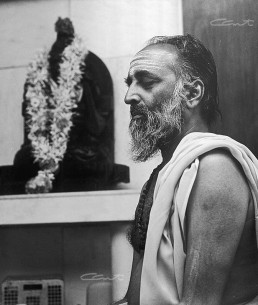
In the years to come, the great disciple would become a world-renowned Guru, but he was careful to point out the correct direction to his disciples and devotees. His magnetic personality drew people to him irresistibly. Who could fail to be overawed by the majestic magnificent figure in flowing orange robes, glowing with a divine aura, speaking fluently in flawless English in a stream of oratory that bathed one into a state of speechless bliss!
Knowing this, he took care that people did not develop an irrational cult of the Guru, worshipping the form, blind to what it symbolized. As early as 1955, he wrote to a devotee called Meenambal:



But I wanted devotees not to mistake the container for the contained: the body for the Self: the Narayan. This mistake, whether it be in ourselves or in our view of our Guru or Ishtam, everywhere this mistake is ignorance.
But as a technique of developing our Atma-Drishti, we can – and most of us must take in the early stages an alambanam (support) for our concentration and steady vichar, a form suggestive of the Divine, the Eternal: maybe a Guru, maybe an Ishtam. Either see the Guru in the Ishtam or the Ishtam in the Guru.
But here the Real Ishtam in the Guru is the Self of the Guru: the sparkle of joy in his eyes, the aura of cheer around him, the scent of purity that he spreads in his life. These have nothing to do with the form, the word, the shape, the dress etc. of the Guru.
If once this is understood and Guru Pooja is undertaken by any devotee of real bhakti and true faith, the Guru can certainly serve as a stronger and more efficient alambanam than even the representations of the Ishtam. After all, the Guru lives, moves, notes, explains; we can hold him by his beard and ask him our doubts and demand an explanation. His language is known to us. Thus this also can be taken up … if properly understood. Do write to me off and on.
Om, Om, Om,
Thy own Self
Chinmayananda
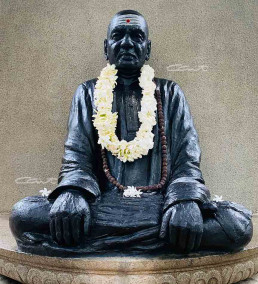
Swami Tapovan Maharaj

Related Links
Swami Tapovanam
Nothing found.
From Gurudev's Pen
Nothing found.
Master Manager
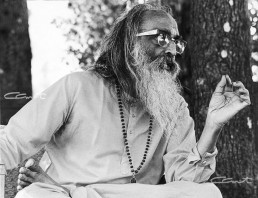
The spectacular success of Pujya Gurudev in reaching the message of our scriptures to the people at large was in no small measure the result of his acumen in understanding human nature and bringing out the full potential of every individual, not only in the spiritual arena, but also in worldly affairs. Not everyone is evolved spiritually to engage in meditation right away. So he created appropriate fields of activity, which would allow full play of a variety of individual talents and at the same time direct the person on the spiritual path. For example, a person who loves teaching can run a Balavihar class, lead a study group or teach in any of the Chinmaya Vidyalayas. One who is good at financial management has his work cut out in running an ashram. He taught many people how to organize a jnana yajna and trained them so well that they would be the envy of professionals in event management.
Under his efficient and inspiring guidance, Chinmaya Mission grew by leaps and bounds, spreading its wings all over India and abroad. He imparted administrative skills to all the acharyas also, equipping them to run local centres, while imparting spiritual teaching in the community. His far-reaching vision initiated the social work and health education program in Sidhabari, which has now expanded into a full-fledged Chinmaya Organization for Rural Development called CORD.
Advice about men and matters abounds in his letters. He teaches people how to handle situations, how to relate to others, how to grow spiritually, by performing actions selflessly as an offering to the Lord. Below is a small collection of Gurudev’s letters on these topics.
Nothing found.

The spectacular success of Pujya Gurudev in reaching the message of our scriptures to the people at large was in no small measure the result of his acumen in understanding human nature and bringing out the full potential of every individual, not only in the spiritual arena, but also in worldly affairs. Not everyone is evolved spiritually to engage in meditation right away. So he created appropriate fields of activity, which would allow full play of a variety of individual talents and at the same time direct the person on the spiritual path. For example, a person who loves teaching can run a Balavihar class, lead a study group or teach in any of the Chinmaya Vidyalayas. One who is good at financial management has his work cut out in running an ashram. He taught many people how to organize a jnana yajna and trained them so well that they would be the envy of professionals in event management.
Under his efficient and inspiring guidance, Chinmaya Mission grew by leaps and bounds, spreading its wings all over India and abroad. He imparted administrative skills to all the acharyas also, equipping them to run local centres, while imparting spiritual teaching in the community. His far-reaching vision initiated the social work and health education program in Sidhabari, which has now expanded into a full-fledged Chinmaya Organization for Rural Development called CORD.
Advice about men and matters abounds in his letters. He teaches people how to handle situations, how to relate to others, how to grow spiritually, by performing actions selflessly as an offering to the Lord.
Below is a small collection of Gurudev’s letters on these topics.
Nothing found.
How to work
Pujya Gurudev showed not only how we should act in the world outside, but also the inner springs of action that lead to material success and spiritual liberation. Some of his letters give us a glimpse of how he worked, and others light our path by inspiring us to bring out our best. His own life was a dazzling example of how to express one’s inner beauty in a dynamic flow of work that nourishes everyone and everything in the yajna spirit.
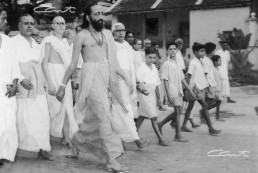

Gurudev's message on Sivaratri day, 1958. He wanted this letter to be read at all centers.
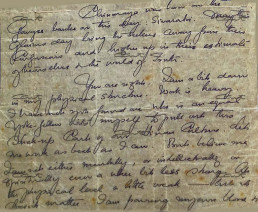
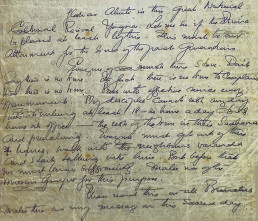
Chinmaya was born on the Ganges banks on this day: Sivaratri. May this glorious day bring the seekers away from the confusions and higher up in their estimate of themselves and the world of Truth.
You are right. I am a bit down in my physical structure. Work is heavy. I have not yet found one who is an equal yoke-fellow with myself to pull out this stuck-up cart of our Hindu culture. Let me work as best as I can. But believe me I am not either mentally or intellectually or spiritually even a wee bit less strong. At the physical level a little weak – but it doesn’t matter. I am pouring my own blood and flesh as ahuti in this great National Cultural Revival Yagna. Let me see if the Divine be pleased at least by this. This must be our atonements for the sins of the past generations.
Every one of us must thus strive. Don’t say there is no time. In fact there is no time to complain that there is no time. Press into effective service every spare moment. My disciples cannot rest any day without working at least 18-20 hours a day. 6-8 hours at office – rest of the time in their sadhana and preaching. Everyone must get out of their houses, walk into the neighbours varanda and start talking with him. But before that we must know sufficiently. Make use of the mission groups for this purpose.
Please read this in all branches. Make this as my message on this sacred day.
While his strength was ebbing and his heart was under tremendous strain in the later years, he could write about it in a light vein and encourage the workers:
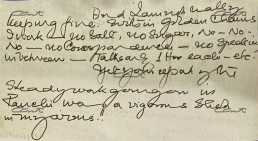
And I am not really keeping fine. Within golden chains I work – no salt, no sugar, NO – NO. NO – no correspondence – no speaking in between – talks only 1 hour each Yet your report of the steady work going on in Ranchi was a vigorous shot in my arms!!
Gently, in small measures, Gurudev inculcates the spirit of Karma Yoga in the devotees:
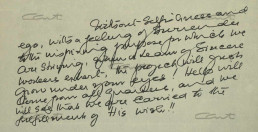
Without selfishness and ego, with a feeling of surrender to the inspiring purpose for which we are striving, when a team of sincere workers exert, the project will just grow under your eyes! Help will come from all quarters, and we will see that we are carried to the fulfillment of His wish!!
While organizing the very first jnana yajna in Pune, Pujya Gurudev allays the fears and worries of the organizers, kindles their faith and strengthens their confidence.

Money is not everything. It is not money that accomplishes. We Divine Lifers must learn to revalue our ideas and our approaches to life. Lord is the Supreme. He is the Accomplisher. His Grace is gold and silver.
We start the yagna on Dec. 31st. Let us fix the date and with faith in Him act in total surrender to, deep devotion in, and constant remembrance of Him, the … of our hearts’ secret cave!! We shall then know nothing but success.
The fear or worry at keeping 2-3 sadhus for 100 days need not be thine. We are seasoned workers; even under any wayside tree we can sleep. Neither Nandaji nor Shantilalji should be bothered for this. Any old temple ruin is place comfortable enough for us. And as to our food – we are not Rajas but Bhikshus at eating!! The Lord who is feeding us here is not a power who has no authority in the Bombay Province. Lord is not a mortal civil supply officer with authorities only over the ration – cards of his Province!! Why worry upon these minor matters? Stop such worries.
Gurudev encapsulates the ideals of Karma Yoga in his advice to Sadhana Mull.
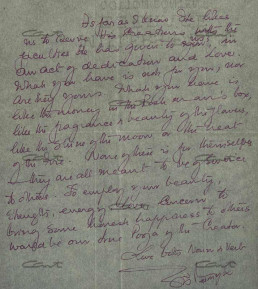
As far as I know He likes us to serve His creations with the faculties He has given us, in an act of dedication and love. What you have is not for you, nor are they yours. What you have is like the money in the Postman’s box, like the fragrance and beauty of the flowers, like the shine of the moon or the heat of the fire. None of these is for themselves – they are all meant to be of service to others. To employ your beauty, strength, energy, love, concern to bring some honest happiness to others would be our true Pooja of the Creator.
Pujya Gurudev shows a volunteer the right way to build and inspire a team.

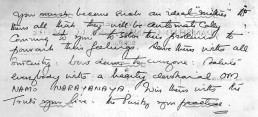
Congratulations. It is He who selects His workers, and not by the members of the Mission. Lord has called upon you to do His job: and His choice can never be wrong.
Be ever in unison with Him through study, kirtan, and regular meditation. Live in self control, in goodness, in purity. Surely then, from moment to moment He will guide you in all activities, making you fulfil His Plan. Be a servant of the Lord of Lords.
The main job of yours must be to see that the members are ever kept in a spirit of one family. You must become such an ideal mother to them all that they will be automatically coming to you to solve their problems: to pour out their feelings. Serve them with all sincerity: bow down to everyone: salute everybody with a hearty devotional OM NAMO NARAYANAYA. Win them with the Truth you live: the purity you practice.
At a personal level, Gurudev worked very hard, relentlessly dedicating himself to his goal of spreading the knowledge of Vedanta. During a retreat in Uttarkasi in May 1969, he writes to Hamsa Salvi:
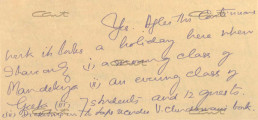
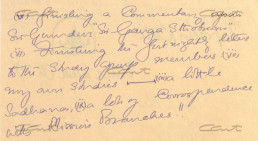
Yes. After the continuous work, it looks a holiday here when I have only (i) a morning class of Mandukya (ii) an evening class of Geeta (iii) 7 students and 12 guests (iv) dictating on to tape recorder Viveka Chudamani book (v) finishing a commentary upon Sri Gurudev’s “Sri Ganga Stotram” (vi) finishing the fortnightly letters to the study group members (vii) my own studies (viii) a little sadhana (ix) a lot of correspondence with Mission Branches!!
Previous Topic
Nothing found.
Next Topic
Nothing found.
Related Topic
Nothing found.
Organising Events
Pujya Gurudev taught many people how to organize a jnana yajna and trained them so well that they would be the envy of professionals in event management.

In 1951 while planning for the first Jnana Yajna, Swamiji encourages a young Seshadri.
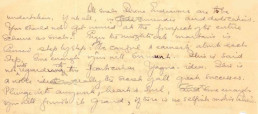
All such Divine endeavours are to be undertaken, if at all, in full surrender and dedication. You should not get worried at the prospect of the entire scheme as such!! Even the mightiest mountain is crossed step by step: only be careful and earnest about each step. Sure enough you will surmount. This is said not with regard to this particular yagna-idea. This is a noble ideal – really the secret of all great successes. Plunge into any work, heart and soul, and sure enough you will finish it grand, if there is no selfish motive behind.
In an undated letter to the committee members in the early 1950s, Pujya Gurudev writes about the attitude in which a jnana yajna should be organized.

Yagnas are organised in fact by the Lord Himself. Yet He has selected us to be His instruments to organise and conduct this yagna. We must feel proud that we are the loving recipients of His grace. Let us do the job as best as we can, dedicating it entirely to Him as our respectful oblations.
More than what we do, it is how we do it that is important in spiritual offerings. Let there be complete coordinated militant team spirit in all the undertakings and activities of the committee. Let us all, in a coordinated discipline under the benign leadership of our president, learn to work selflessly in devotion and dedication unto Him to accomplish this yagna which is essentially conducted to spread spiritual values in these dark days of passion and lust.
May your teamwork and dedication inspire the whole town. May our work bring a shower of His grace on the people.
Pujya Gurdev floods this letter to Lakshmi Reddy with so many inspiring gems, motivating devotees to act, along with guidance on how to perform actions.


Please read this letter out to the members of our team of workers there.
Soldiers of the Renaissance Army! The eternal voice of the Rishis salute you. You are serving a great cause and are accomplishing a divine task.
The cultural resurgence of a decadent society is no earthly achievement; it is a divine act of the Supreme Will. In such a godly endeavour we must learn to serve without the least ego, fear, passions or anxieties.
Lakshmi Pathi, Sree Narayan, dressed up to drive us Home as Parthasarathi is the only organizer-in-chief of all these yagnas. You all come next in importance the audience and last comes the requirements such as volunteers, place, time, and the Swami himself. The committee are the nearest to Him and His prabhav, and I expect each member of the committee to renounce all their mental reservations, personal vanities, individual plannings. Be ready to serve … strive … rest in Him in faith and goodwill … pray ever to be His faithful instruments … watch on. What a glorious dividend of success we reap for our efforts! To such a self-surrendered servant of the Soul, the parade of happenings — success and failure is but a glorious vision of His Leela.
Renounce all anxieties. Meet each devotee and explain the work we are doing, ask for their cooperation and help – and watch. Even when you get a refusal to help from individuals, watch on! Watch on in perfect detachment to see Him talking through that individual. Smile at refusals; smile at those who offer help; all activities are His play; Sree Narayana’s own expressions everywhere. Success is ours if we know how to work in surrender unto Him – for He knows no failure ever!!
In the mid-1950s, when the jnana yajna was evolving into a beautifully structured event, Gurudev sends clear instructions to his cousin Bhaskara Menon about the preparatory arrangements and publicity.

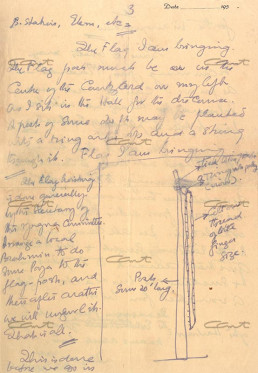
Arrange the notices to be distributed by the newspaper men, the wall pictures everywhere in Cochin, Trippi, Varkala, Valanjambalam, N. Station, S. station, Ekm etc.
The flag I am bringing. The flagpost must be in the centre of the courtyard on my left as I sit in the hall for the discourse. A post of some 20 ft may be planted with a ring on the top and a string through it. Flag I am bringing.
The flag hoisting is done generally by the secretary of the yagna committee. Arrange a local brahmin to do some pooja to the flagpost, and then after arathi we will unfurl it. That is all.
This is done before we go in for the inauguration.
Gurudev defines the criteria by which the success of an event should be measured.

I do not evaluate Chinmaya Yagnas in terms of the publicity or the number of people who attended. I generally rate the yagna in terms of the amount of team-spirit the Yagna Committee is capable of generating and manifesting during the organisation and conduct of the yagna.
In the 1950s, when people were not yet clear about the way a yajna had to be organized, there were many hiccups and hurdles. But Gurudev took them all in his stride and won over the people with his talks.

Just reached here only to find that arrangements are poor, friends are nil, patronage zero, and enthusaism frozen. And yet I am sure I will act and win in the end. This is not my work; why should I worry. Rishis are capable of fulfilling their own so sankalpa!!
In fact I like the start to be cold – so that when we warm up the entire thing will look like a spectacular expression of His Own Hand by contrast.
Keep up your health. Don’t destroy it. Work only as a means for steadying the mind: as a means for sadhana. When work seems to work on you, leave it. You work at something; let not the work do something to you.
Previous Topic
Nothing found.
Next Topic
Nothing found.
Related Topic
Nothing found.
